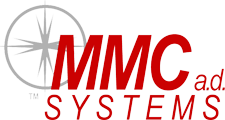History of Innovation

MMC AD Systems was founded in 1975 in Palo Alto, California and has a history of innovation.
Its initial mission was the development and operation of the Cardiac Patient Index System (CPIS), a multi-user interactive medical database system that was primarily used to evaluate new medical procedures. Most of the early company employees were nurses who extracted medical information from hand written patient records and filled in specially designed mark sense forms. The initial database system ran on a DEC PDP-11/20 computer system using a company developed operating system. The database system was also written in a company developed interpretive language called Record. The initial system supported more than a half-a-dozen simultaneous users. With the completion of the system, the company moved on to develop an accounting system for a small chain of stain glass stores. The delivery of the accounting system marked the end of the first phase of the company’s existence, and the entry into a period of minimal activity, as the company principals scattered to the four winds.
In 1987 at the request of several major software developers, the company began developing the C Programmer’s Toolbox™ for the PC (Windows), Apple Macintosh (MPW), and Unix (Sun Solaris). Over 18 months three volumes of tools were developed and marketed. Some enabled the study of C and C++ code. Others assisted taking third party code, interpreting it and transforming it into a common form to make it easier for integration into existing programs. A third set of tools assisted in the automatic identification and removal programming bugs. Another set of tools helped a developer significantly improve the performance of his program, either by minimizing resource usage or by increasing the speed of execution. A final set of tools help managed the users environment. While the toolbox was highly successful in its small market niche rising to either #1 or #2 in each platform, we learned, as have others, that it is virtually impossible to make a major commercial success out of any type of software tool. The most successful have been companies that make compilers. Even these companies have struggled to maintain any kind of success since there might be three companies today that still successfully selling compilers as a primary business.
Many have asked where did the company name come from, and what does it stand for. Simply MMC is roman numerals for 2100. The company name is simply a year in the future. We chose the name when we started building systems that did seemingly impossible things (e.g., 64 K of memory and 6 users).
In the early 1990’s Call Centers became an important channel for companies to provide customer service, and eventually sales (e.g., airline tickets and catalog sales). Call Centers required new business processes, personnel with new skills, and emerging computer telephony technology (e.g., telephone switches, computer networks, servers, workstations and various enterprise software applications). For the next six years, we helped various consulting, telecommunication, and call center outsourcing companies define and create the business methodology, best practices and the integrated computer telephony technology that are the foundation of Customer Care and Contact Centers today. Throughout this period, we helped build and operate various small, medium and large call centers around the world for the largest companies in the world. These activities eventually drew us into helping several companies reshape and re-engineer themselves around their call center (sales and service) operations.
In 1996, we helped form a new business, Channel Concepts, Inc., whose primary purpose was to help businesses re-engineer their sales, marketing and service programs around alternate, emerging channels. These channels included the telephone, world-wide-web, direct mail and email. Through our work with major financial institutions, telecommunications and SFA companies, we demonstrated the need for a single point of contact in a business for key customers. In addition to providing higher quality service to these customers, this methodology also provided a large cost reduction when handling large customer contact volumes. This methodology was so successful that it served as the foundation for Customer Relationship Management (CRM) and the development of world-class customer care centers.
We transitioned into helping various individuals and companies form new business ventures. Our focus has been on building them into viable business concerns. As we worked with these companies, we helped push the technical envelope in mobile real-time video, cloud computing and virtual meetings to mention a few.
While it is easy to invent new products or services, it has been getting progressively more difficult each year to gain the initial market and sales traction necessary to be successful. Both businesses and consumers are constantly inundated with new products and services, which all claim to make their lives better in some fashion. A new business’s challenge is to determine who their best prospects are, and to gain their attention. Unlike the old days, the new early buyer must really need the product, be capable of using it on a daily basis, and be willing to demonstrate its use for other potential buyers.
In addition to working with various investment groups in search of the next breakthrough product, we have also worked with several business incubators in the San Francisco bay area.
Since we’ve intimately over the years with C-Level management of companies of all sizes, we recently added ‘leadership coaching’ to our service offerings. While we informally provided the service on a gratutious basis over the years, we now have been doing it on a more formal basis with both non-profit and for-profit organizations around the world.
We are already looking forward to and participating in the next big evolution.
Share this:
Recent Comments